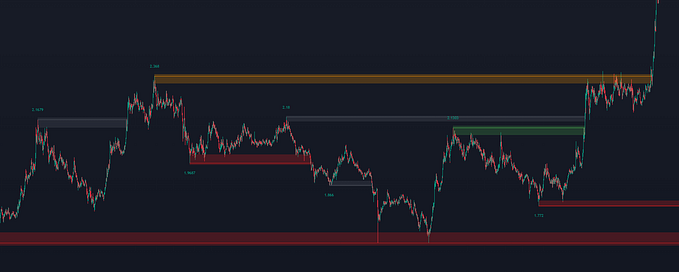Understanding Candlestick Charts

As a beginner in crypto trading, reading the charts can be confusing. To understand a trading pattern, one must first learn about the fundamental components: the candlesticks. This article will introduce what a candlestick chart is and how to interpret it.
What is a candlestick chart?
The candlestick chart shows the price movement, which is recorded in candlesticks. It was invented in Japan in the 1700s by Munehisa Homma. The chart was originally used in the rice futures markets to show rice’s price fluctuations. Now, it’s adopted worldwide and is applied to stocks, commodities, currencies, and even cryptocurrencies.
How to read candlesticks?
A candlestick represents the price movements of fixed time intervals and distinguishes an uptrend or a downtrend with different colors. Here we will use 1-minute candlesticks from the Aboard exchange as a demonstration.
A green candlestick represents an uptrend on Aboard exchange, and a red candlestick stands for a downtrend. For example, a 1-minute green candlestick suggests the price went up in the past minute. Besides color, each candlestick has four price points:
- Open price —The initial trading price of the asset in that time interval;
- Close price — The last trading price of the asset in that time interval;
- High price —The highest trading price of the asset in that time interval
- Low price —The lowest trading price of the asset in that time interval
With a green candlestick that shows an increase in the trading price, the open price is below the close price; and with a red candlestick that shows a decrease in the trading price, the open price is above the close price.
The open price and the close price determine the size of the candlestick body, the rectangle section. A more considerable price difference in the opening and closing price will lead to a larger body section and vice versa. The high and low prices determine the thin lines on either end. The line is also called wick length, or range.
What do candlesticks tell us?
The candlesticks offer valuable information about the market via the four price points, often called the OHLC prices (Open-High-Low-Close). On a high level, the OHLC data shows the battle of two forces, the bull, and the bear. In each trading session, the bull force drives up the price by purchasing, and the bear force pushes down the price by selling. Here are a couple of classic patterns:
Doji
A doji is a cross-shaped candlestick where the opening and closing prices are the same or very close. Such patterns show neither the bull force nor the bear force is in control, and the force is balanced. Technical analysts have different interpretations of the doji pattern: some traders believe a doji pattern indicates a reversal, while others may view it as a breakout point.
Gravestone Doji
A gravestone doji is a unique form of doji that the open and close are near the low with a long upper wick. The story of a gravestone doji is that the bull force attempts the push the price to new highs but is eventually pushed back by the bear force at the end of the trading session. The long upper wick represents the bulls losing momentum. Many believe the gravestone doji indicates an uptrend reversal; therefore, traders tend to open short positions or exit long positions after identifying a gravestone doji.

Dragonfly Doji
A dragonfly doji is also a unique form of Doji that the open and close are near the high with a long lower wick. A dragonfly doji suggests that the seller dominates initially but is later pushed back by the buyer. A Dragonfly Doji is commonly used as a reversing signal: a dragonfly doji after an uptrend may signal a downtrend as the seller is entering the market, and a dragonfly doji after a downtrend may suggest a rise is coming.
Shooting Star
A shooting star has a small body near the low and a long upper wick. The upper wick must be at least twice as large as the shooting star’s body. The narrative of a shooting star is that price goes up sharply during the session but is later taken over by the sell-side and drives the price back down. Many consider the shooting star as a reversal and price top indicator, especially when the next candle is lower than the high of the shooting star.
Hammer
A hammer candlestick looks like a hammer with a long tail and a small body near the top. The lower wick must be at least twice as large as the hammer’s body. In a hammer’s case, the selling force significantly drives the price down during the interval, but the buying force regains dominance and pushes the price back up. A hammer is considered a bottom indicator when found in a downtrend.
Traders often use candlestick patterns in technical analysis; however, what happens in the past never guarantees the future’s outcome. A prudent trader should consider multiple factors before making a decision. For example, it is always good to analyze more past candles after identifying a pattern. Also, the trading volume of each session should be a factor of consideration too.
About Aboard.Exchange
Aboard is an order book decentralized derivatives exchange that will bring centralized trading experience into the DeFi world. Aboard currently has token and index perpetual futures available. Aboard will launch more derivative products, including additional token and index perpetuals, options, and more in the future. Aboard will also launch an Advisory protocol that uses smart contracts to connect crypto investors with DeFi fund managers. The protocol eliminates all intermediaries and directly ties crypto investors with fund managers in a trustless and transparent way.







